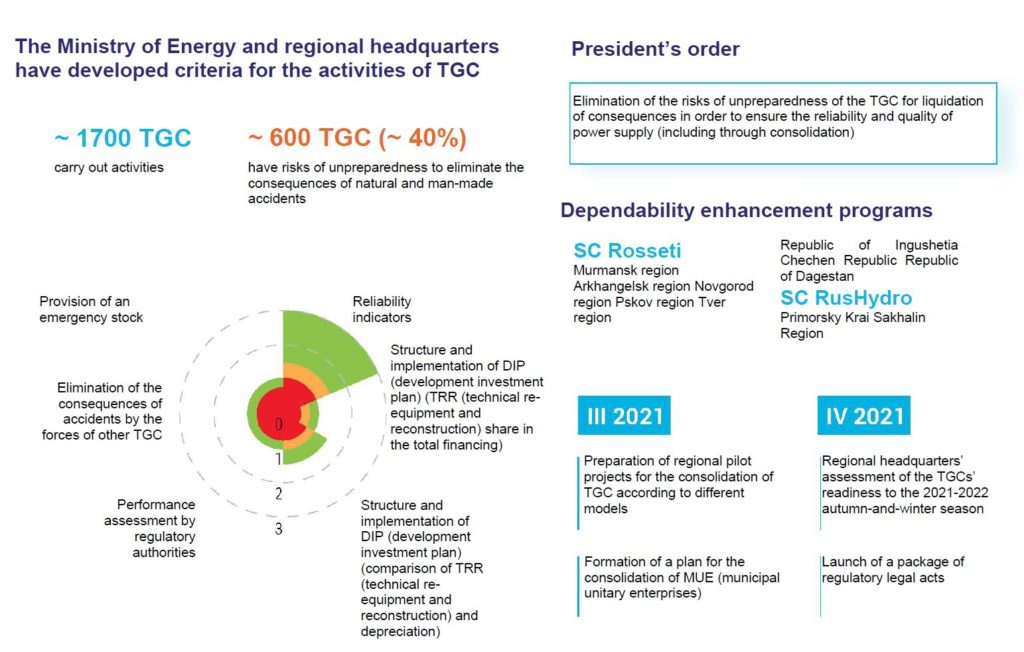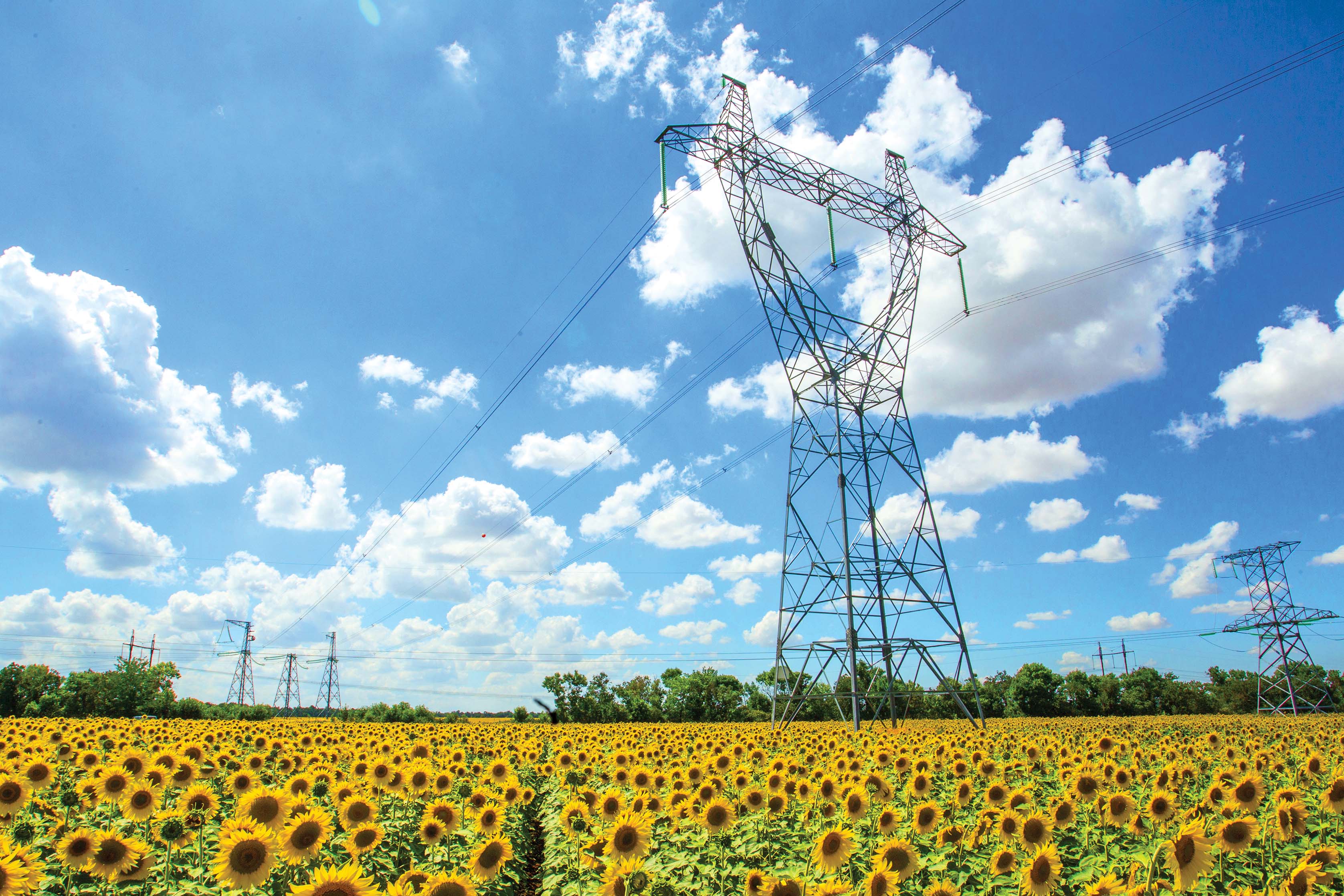Evgeniy GRABCHAK
Deputy Minister of Energy of Russia
An indicator of the efficiency and effectiveness of the work of power generation industry employees is the reliable and uninterrupted power supply to consumers – both the citizens and the industrial enterprises. Since electricity is a commodity that needs to be provided to the consumer continuously, the functioning of power grid companies, as well as all subjects of the electric power industry, is of particular importance.
Each season brings certain difficulties for power industry employees. In summer, at prolonged high temperatures, the load on the power grid equipment significantly increases, due to both the non-design conditions for the equipment operation and an increase in power consumption due to the massive use of climatic technology (air conditioners), and the likelihood of the negative impact of forest fires and floods increases as well. In spring and autumn, there are often so-called “0 crossings”, when temperature transitions over 0 degrees, often accompanied by heavy precipitation, cause the formation of ice and frost deposits on the wires creating an additional mechanical load on all elements of high-voltage lines, leading to their damage. In winter, in addition to difficult operating modes of equipment at maximum loads, any power supply failure can have more serious consequences for consumers, due to the significant negative ambient air temperature.
The Ministry of Energy carefully analyses all emergencies that occur. If in high voltage networks (110 kV and above) we have seen a stable trend for a decrease in their number for several years (for example, according to the results of the autumn-winter period of 2020–2021, the accident rate for high voltage equipment decreased by 7%), then in distribution networks (0.4–6–10 kV), the situation is reversed.
The Ministry of Energy records for a number of TGC that even with design climate impacts on the power grid infrastructure, power supply disruptions occur, affecting a significant number of consumers, which indicates a significant level of wear of distribution networks, caused, among other things, by a low level of operation over a long period of time.
If we talk about non-design, abnormal climatic influences, for example, as occurred last year in Vladivostok, the most important thing here is to react promptly, to ensure the fastest possible restoration of power supply to consumers by eliminating damages, connecting backup power sources or implementing circuit solutions. Reliable power supply to consumers is a priority task for all power generation industry employees. In the course of outages, we faced a situation when a company, whose operational responsibility scope included the de-energized facilities, was unable to properly fulfil its obligations and restore power supply to consumers. In such cases, we attracted the forces and funds of other, larger power grid companies, and they helped to restore the energy supply to consumers. Of course, this should not happen. The Ministry of Energy of Russia is consistently working on enhancement of the territorial grid companies’ activities.
Prerequisites
Today, the greatest risks from the point of view of ensuring the reliability of consumers are associated with the deterioration of network assets, primarily the voltage level of 0.4-6-10 kV (distribution networks), on which residential consumers are mainly connected. The shutdown of such equipment has significant social consequences, which is most clearly manifested in the event of mass outages of consumers.
One of the reasons for the significant deterioration of grid facilities is improper operation of power grid equipment, which is largely due to distortions in the planning and implementation of investment programs, which are approved and monitored at the regional level.
Thus, only 30% of TGC have investment programs. In 2020, their funding was only 72% of the planned amount. The analysis of the structure of these investment programs showed that the problems of high wear and tear of fixed assets of the distribution grid complex are not being solved.
The lack of approved investment programs, as well as insufficient financing of activities to maintain the technical condition of the TGC, directly have a negative effect on the quality of energy supply to end consumers and, first of all, to the population.
Enhancing the power supply reliability
- The work on increasing the reliability and improving the quality of power supply is performed in several directions.
- Thus, we are making changes to the methodology for assessing the readiness of electric power industry entities to work during the heating season:
- – assessment of the level of risks of disruption of reliable operation of electrical networks of 35 kV and below by calculating the reliable functioning index (RFI);
- – assessment of the criticality of failure to comply with the planned technical impacts upon completion of the repair;
- implementation of specialized indicators characterizing the reliability of PTL with a voltage of 110 kV and above.
- Such changes will make it possible to more objectively assess the readiness of the subjects of the electric power industry to work during the heating season; to place accents, taking into account possible risks and consequences during the heating season as a result of the application of risk-based indicators; eliminate the risks of unpreparedness of territorial grid organizations to eliminate the consequences of accidents to ensure the reliability and quality of power supply.
- Enhancement of the TGC criteria is performed on an ongoing basis. Thus, in 2015, the Government of the Russian Federation approved the TGC criteria, whose application led to a decrease in the number of territorial grid companies in Russia by 47%. Currently, about 1,700 TGC are registered in our country

A feature of the power grid complex is the presence of several TGC in one geographic area. Firstly, this leads to a violation of the principle of uniformity of technical solutions, and secondly, to duplication of operating costs and investment costs.
Herewith, new TGC appear, which are rapidly increasing the total revenue from the provision of services for the transmission of electrical energy, although consumers do not always receive reliable and high-quality power supply.
In addition, small TGC often do not have sufficient resources for the proper operation of facilities of power grid and prompt emergency recovery work, which we recorded in the last heating season. As a result, the power supply of consumers was restored by other TGC, on which the load on liquidation of an emergency situation in the conditions of outages, including their own equipment, increased significantly.
In order to avoid the risks of unpreparedness of the TGC to eliminate the consequences of accidents, the Ministry of Energy of Russia, together with the regional headquarters, analysed the activities of territorial grid organizations that own facilities of 35 kV and below. The analysis was performed according to a number of criteria, which include indicators of reliability, the results of investment activities aimed at maintaining the technical condition, provision of an emergency stock and the organization of emergency recovery work.
As a result, about 40% of regional grid companies (about 600 TGCs) do not ensure the maintenance of their facilities in the required technical condition. This significantly reduces the reliability and safety of energy supply to end users.
Already today, large TGCs solve the problem of increasing the level of reliability through the targeted programs. This year, they began their implementation in 10 regions: Murmansk Region, Arkhangelsk Region, Novgorod Region, Pskov Region, Tver Region, Republic of Ingushetia, Chechen Republic, Republic of Dagestan, Primorsky Territory, Sakhalin Region.
For a comprehensive solution to the problem of increasing the level of reliability, we have developed a draft action plan for amending some regulatory legal acts.
First, we are strengthening the role of regional headquarters in assessing the preparedness of the TGC for the heating season and the elimination of the consequences of accidents. We empower them to monitor the emergency stock.
Secondly, we supplement the current methodology for monitoring the readiness for autumn-winter period with new indicators for assessing the risks of disruption to the operation of the grid complex with a voltage class of 35 kV and below. Indicators include an assessment of a number of basic parameters: availability and completeness of the emergency stock; implementation of investment programs for the commissioning of new and reconstructed facilities; the presence of equipment with an excess of the standard service life and in an unsatisfactory technical condition; the duration of the elimination of accidents; and a number of others. Based on the specified information, a comprehensive index of risks of malfunctioning will be formed, according to the following formula:
ИНФ = Σi (КГi х ИВГПi) х 100, where:
КГi – the value of the weighting coefficient for the i-th group of conditions for indicators of reliable functioning of the territorial grid organization;
ИВГПi – the calculated value of the performance index for each group of indicators of reliable functioning.

Source: wikimapia.org
The calculation and formation of the index of risks of malfunctioning will be performed according to a methodology similar to the already existing and well-proven methodology for assessing the readiness of subjects to work in the heating season. When a certain threshold value is reached, a decision will be made on attributing a specific TGC to a high level of risk of malfunctioning. If it is repeatedly referred to a high category of risk of disruption to the functioning of the TGC, it will lose its status. Under current conditions, if the status of a TGC is deprived, the owner of power grid facilities can form a new legal entity, obtain the status of a TGC and continue to provide services to consumers in bad faith. We propose to limit this possibility.
Thirdly, in each region, a backbone TGC (regional operator) will be determined for operational and technological management and emergency recovery work in relation to power grid facilities, the owner of which has lost the TGC status, until the transfer of these facilities to another owner. It is planned to establish criteria for determining the status of a regional operator, its powers and requirements for it.
This work is also performed within the framework of the execution of the instruction of the President of Russia dated December 31, 2020 to eliminate the risks of unpreparedness of the TGC to eliminate the consequences of natural or man-made accidents in order to ensure the reliability and quality of power supply in the constituent entities of the Russian Federation, including through the consolidation of network assets on the basis of the largest backbone power grid organization operating on the territory of the corresponding subject.
We believe that this integrated approach will significantly increase the reliability of the TGC operation and, as a result, minimize the risks of disruption to the power supply to consumers.







